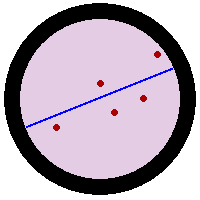We created a model that would attempt to accurately evaluate the implementations of the Centers for Disease Control and Prevention (CDC) in response to Covid-19. We first used the information gathered in our model to identify how many total people in the United States would become infected without the introduction of the CDC guideline of hand washing. Then, we did the same, but this time we introduced the idea of hand washing throughout different times in our model. We watched how the results differed depending on the time guidelines were enforced. Ultimately, only .13% of the population became infected once hand washing was strictly enforced from the very beginning (20 days after the first case to be exact), as compared to the 94.68% that became infected when hand washing was not enforced or enforced at a later date.
The lynx-hare populations are a prototypical example of a predator prey relationship. This paper discusses how a unique metric, stress, can affect the snowshoe hare population enough to cause distress amongst the lynx population. To test this, we used a modified version of the SIR model that utilizes variables to represent the time elapsed, the initial snowshoe hare population, and the initial canada lynx population. After a simulation of 10,000 days, our model demonstrates that increasing levels of stress in the snowshoe hares can burden the lynx population, to the extent of nearly wiping the lynxes out.
Amid the spreading of the highly infectious Covid-19, there is a need to explore how this virus will impact people economically. To show this, the SIR model was used to predict the infected number of people in the labor market for a period of six months and the tax loss was calculated at the progressive tax rate of NY State using the average income in each borough. Our result shows that among all the five boroughs, Manhattan is the one affected the most due to its highest average income compared to the other four boroughs.
In this study, we examined the effect of lockdown measures on the rate of infection of COVID-19, caused by SARS-CoV-2, in order to predict the course of the pandemic in New York City. We used data from the New York City Department of Health as well as from our research of other countries with varying response times to COVID-19 in order to build an SIR model to estimate the effects of the lockdowns on the rate of infection in New York City. We found that lockdowns slow the infection rate and lower the peak, and that later response times disproportionately raise the peak and lengthen the outbreak. Additionally the lockdown measures need to remain in place in order to keep the outbreak under control.
In this paper, we highlight the differences between the responses to the outbreak of the coronavirus pandemic in Sweden and South Korea. We create a simulation to translate the rates of death, spread, and recovery to a fixed population in order to compare the effectiveness of each country. We find that South Korea was more effective at containing the spread of the virus and treating the virus.
With quarantines and low flight activity across the world, airline companies struggled to make ends meet. The goal of this experiment was to examine which airline company would file for bankruptcy first. We developed a SIR model simulating COVID-19's interaction between the United States and five international countries using distinct airlines over six months. By performing a mutually exclusive tuple-pair simulation using the United States and the foreign countries asynchronously, the results conclude that no airline will undergo bankruptcy.
Our simulation was aimed to investigate the effectiveness of immunizations and face masks. We created an SID model that shows the effect of Pneumonia on the population of New York. We ran our simulation for a 196-day period in order to see how masks and immunization would affect the New York population. After about 6.5 months of running our simulation we came to the conclusion that masks reduced the rate of infection.
This paper explores the effects of social distance and the chance of the population getting the coronavirus in Italy during this year. We used python to simulate a modified SIR model that included variables for social distance and the complement of the death count. After the simulation ran several times, our results showed that social distance reduced the infection rate and, as a consequence, the death rate of the general population.
In March 2020, the COVID-19 or Coronavirus appears in New York City. Even today, the virus continues to spread, more people get infected and died. This paper investigates how the future population of NYC get impact by Coronavirus and how will 30% of NYC resident staying home policy help NYC residents save their life. We used python to simulate a modified SIR model that included variables for staying home effective rate and death rate. The infected rate and death rate will significantly decrease after 30% of NYC residents begin to stay at home. We conclude that staying home will help NYC residents stay away from the Coronavirus.
